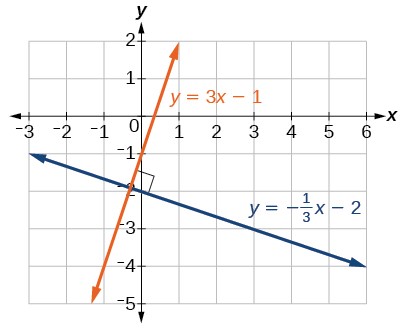Parallel/Perpendicular Lines
Make sure to review Slope before looking at this lesson!

|
Two lines are parallel if their slopes are equal and they have different \(y\)-intercepts. If their \(y\)-intercepts are the same, then they would be the same line! |

|
Two lines are perpendicular if their slopes are negative reciprocals of each other. Remember, to find the reciprocal of a number, switch the numerator and denominator (flip the fraction). |
i. First, we can identify the slope of the current line. Recall the equation \(y = m(x) + b\), where \(m\) represents the slope. In this instance, the current slope would be \(-7\).
A parallel line would have the same slope but a different \(y\)-intercept, \(b\).
Therefore, a couple of appropriate answers could be \(\boldsymbol{y = -7x + 2}\) or \(\boldsymbol{y = -7x - 1}\).
ii. A perpendicular line contains a slope that is a negative reciprocal of the original line. The current slope is \(-7\) so its reciprocal would be \(\cfrac{-1}{7}\). Lastly, multiply by \(-1\) to get the negative reciprocal, \(\cfrac{1}{7}\).
Therefore, a couple of sufficient answers could be \( \boldsymbol{y = \cfrac{1}{7}x + 2}\) or \(\boldsymbol{y = \cfrac{1}{7}x - 12}\).
i. First, we can rewrite the equation in slope-intercept form:
\( y = mx + b\)
\(y = \cfrac{2}{3}x\)
We can determine that the slope of the original line is \(2/3\).
A parallel line would have the same slope but a different \(y\)-intercept, \(b\).
Therefore, a sufficient answer would be \(\boldsymbol{y = \cfrac{2}{3}x + 9}\).
ii. A perpendicular line contains a slope that is a negative reciprocal of the original line. The current slope is \(\cfrac{2}{3}\) so its reciprocal would be \(\cfrac{3}{2}\). Lastly, multiply by \(-1\) to get the negative reciprocal, \(\cfrac{-3}{2}\).
Therefore, a sufficient answer would be \(\boldsymbol{y = \cfrac{-3}{2}x + 20}\).
First, we can write the equation in the following form:
\(y = mx + b\)
Since our equation is parallel to the original line, it would contain the same slope, \(4\), but a different \(y\)-intercept.
We can write our current equation as:
\(y = 4x + b\)
Next, in order to determine \(b\), plug the point \((x,y) = (-2, -5)\) into the equation and solve:
\(-5 = (4)(-2) + b\)
\(-5 = 8 + b\)
\(b = 3\)
Then, we can put all the known values into the final equation:
\(y = 4x + 3\)
Therefore, the equation that fulfills all the above conditions is \(\boldsymbol{y = 4x + 3}\).